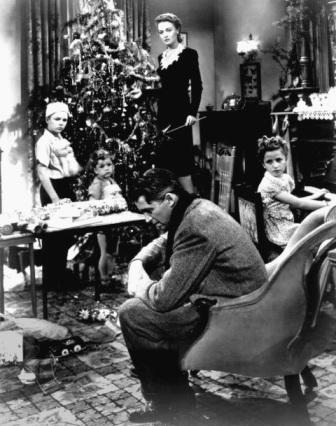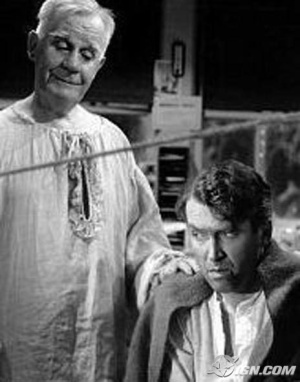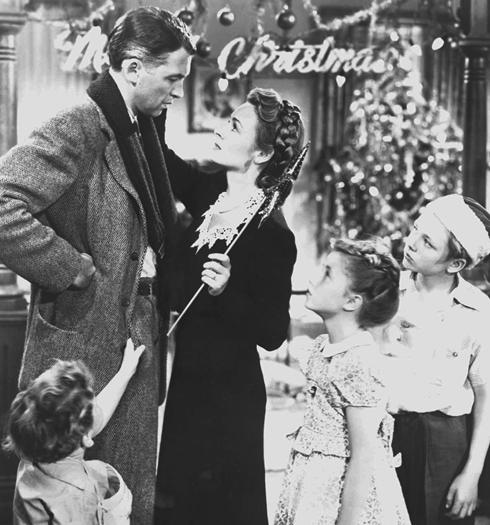 VERTIGO (1958); Dir: Alfred Hitchcock; Starring James Stewart, Kim Novak and Barbara Bel Geddes; Fri. Nov. 23 – Sun. Nov. 25; Plaza Theatre (visit Plaza Theatre Website for showtimes and ticket prices); Trailer here.
VERTIGO (1958); Dir: Alfred Hitchcock; Starring James Stewart, Kim Novak and Barbara Bel Geddes; Fri. Nov. 23 – Sun. Nov. 25; Plaza Theatre (visit Plaza Theatre Website for showtimes and ticket prices); Trailer here.
If the film noir is defined by its most typical set-up—that of a doomed man swept up in events outside his control, often by a manipulative female figure—then Alfred Hitchcock’s towering VERTIGO is that most rare of films noir. It trades the genre’s high-contrast black-and-white for rich Technicolor. It places its characters not in the dimly-lit nightshade world of seedy bars, backrooms and private dicks’ offices; but in art museums, redwoods forests and the sunny streets of San Francisco. In the world of VERTIGO, the shadows of night may still hold mysterious threats, but the stark light of day reveals their constant presence all too clearly. There is, truly, no escape.
In this film, James Stewart paired with Hitchcock for their final collaboration. Stewart had long been one of Hitch’s archetypal actors. Whereas Cary Grant represented the Idealized Man in his cinematic world, Stewart was the Everyman. Grant was the go-to guy when Hitch needed a lead that viewers would either want to be or want to bed. Stewart was the guy next door, bringing a down-to-earth sensibility to his roles, and much of the attraction of him as a lead in Hitch’s films was in seeing this average Joe rise above his limitations to triumph at the end.
In VERTIGO, however, Stewart’s average Joe is taken far away from next door; his obsessions and fears exposed as he is broken beyond repair.
Stewart stars as former police detective John “Scottie” Ferguson, whose vertigo and fear of heights manifest in a rooftop police chase and result in the death of a fellow officer. Stricken by depression, he has retired from the force and struggles to overcome his fears. He is enlisted by an old college acquaintance, Gavin Elster, to trail his wife Madeleine (Kim Novak), whom he claims has been possessed by the spirit of the long-dead suicide victim Carlotta Valdes. Scottie witnesses Madeleine attempt to kill herself by jumping into San Francisco Bay and rescues her. They then become ensnared in an obsessive and doomed romance that can only result in death, a break with sanity, or both…
Kim Novak perfectly essays the role of a most unusual femme fatale: manipulative without being forceful, cool and reserved yet with a barely-concealed sexuality, strong yet fragile. However, Barbara Bel Geddes (whom viewers would later come to know as “Miss Ellie” Ewing on the TV series DALLAS) is perhaps the most overlooked character in the film: Scottie’s long-suffering ex-girlfriend Midge, a bohemian clothing designer, who represents the polar opposite of Madeleine. Where Madeleine is cool, Midge is warm. Where Madeleine is perfectly poised and elegant, Midge is natural and almost frumpily grounded. And where Madeleine represents everything that will tear down Scottie, Midge represents that lost potential for true happiness. Madeleine may be an impossible ideal, but Midge is real, there, now. And her love and devotion to Scottie may be the only path for his salvation, but how can he see that path with the dream that is Madeleine beckoning him from just beyond his reach?
The film was a critical and commercial failure upon release. Some felt it was too long and too complicated for a simple psychological mystery. Hitchcock believed that James Stewart’s age was a factor in the film’s failure, and replaced him with Cary Grant in the following year’s NORTH BY NORTHWEST (four years older than Stewart, true, but eternally youthful). Many, however, were disappointed that this movie was not another romantic mystery along the lines of 1956’s THE MAN WHO KNEW TOO MUCH. In fact, the mystery is practically subservient to the film’s depiction of obsession—it’s solved two thirds of the way through the movie. Hitchcock often referenced the term “MacGuffin”: the mechanical element that sets a story into motion, yet which is ultimately unimportant to the plot’s progression. In John Huston’s 1941 film THE MALTESE FALCON, for instance, it’s the titular sculpture. In NORTH BY NORTHWEST, it’s a cache of microfilm. In the case of VERTIGO, it’s the mystery itself. The whys and wherefores of how Scottie has become obsessed with Madeleine are not important; his fears and obsessions are, instead, the focal point, and how they emerge and re-emerge during the course of the story are what carries us along the inevitable path to the film’s particularly noir conclusion.
 However it was dismissed in the past, in more recent years VERTIGO has been reevaluated. Beginning with Robin Wood’s seminal 1965 work HITCHCOCK’S FILMS, critics have paid closer attention to the film and what it attempts to accomplish. Many have come to regard the film in retrospect as Hitch’s most personal work: a fully-realized exploration of his own obsession with a particular “type” of woman, embodied in Grace Kelly, and his need to craft the images of his actresses to fit this particular model. This was an obsession, as depicted in Donald Spoto’s THE DARK SIDE OF GENIUS and the HBO original film THE GIRL, which would be ultimately destructive to his professional relationships with women. But despite the speculative personal aspect of VERTIGO, most have come to realize that as a film on its own merits, that it stands as a masterpiece. Indeed, it has topped the British Film Institute’s 2012 Sight & Sound critic’s poll as the greatest film ever made.
However it was dismissed in the past, in more recent years VERTIGO has been reevaluated. Beginning with Robin Wood’s seminal 1965 work HITCHCOCK’S FILMS, critics have paid closer attention to the film and what it attempts to accomplish. Many have come to regard the film in retrospect as Hitch’s most personal work: a fully-realized exploration of his own obsession with a particular “type” of woman, embodied in Grace Kelly, and his need to craft the images of his actresses to fit this particular model. This was an obsession, as depicted in Donald Spoto’s THE DARK SIDE OF GENIUS and the HBO original film THE GIRL, which would be ultimately destructive to his professional relationships with women. But despite the speculative personal aspect of VERTIGO, most have come to realize that as a film on its own merits, that it stands as a masterpiece. Indeed, it has topped the British Film Institute’s 2012 Sight & Sound critic’s poll as the greatest film ever made.
VERTIGO’s relative failure at the time meant that preservation wasn’t as much of an issue. Thankfully, the film was meticulously restored by film historian Robert A. Harris and his team, using materials ranging from the original camera negatives (which Harris notes “looked hideous”), to damaged black-and-white color separation masters, to fuzzy film prints as many as eight generations removed from the original negatives. Using all of the materials at their disposal (including a preserved green paint sample from a model of car featured in the film which was utilized for color timing), Harris and company worked miracles, producing an almost immaculate presentation of what many consider Hitchcock’s true masterpiece.
To see such an important film, preserved and restored so well, presented on the big screen is a treat to be savored by any film fan, whether casual or hardcore. And this treat is available at the Plaza Theatre for one weekend only. Some things simply should not be missed. Don’t let this one pass you by.
Aleck Bennett is a writer, blogger, pug warden, pop culture enthusiast, raconteur and bon vivant from the greater Atlanta area. Visit his blog at doctorsardonicus.wordpress.com






